Chapter 24 Lifting Field–Grown Trees
Often stock trees are planted out in open ground for two or more years to thicken their trunk in preparation for further training. At other times we want to collect “wild” trees. The general approach to lifting field-grown trees is the same in both cases.
I have compiled recommendations of several state Cooperative Extension Programs, and the American Horticultural Society. The process seems simple, but paying attention to timing and a few key details greatly improves the odds of success.
Let’s look at the basic steps first, then break down the details.
24.1 The Basic Process
- Water the tree well each day for two or three days in advance of lifting.
- Before starting to dig the tree, prepare the soil and new box or pot where it will live.
- On moving day, you will need a square-faced shovel with a sharp edge, pruning shears, a pry bar or heavy metal rod, plastic bags, paper towels or cotton rags, and 1-2 gallons of water.
- Remove all weeds or undergrowth from around the trunk, and clip any unnecessary branches.
- Measure the height of the tree or shrub. Using sand or the edge of a shovel, draw a circle around the tree with a radius 1/3 the overall height of the tree. For example, if a tree is 6 feet tall, draw a circle around the trunk with a radius of 2 feet (4 feet total diameter).
- Use the spade to cut a ring around the tree that follows the circle. Angle the bottom of the cuts slightly in towards the tree’s roots. Make the cuts 1-2 feet deep.
- To undercut the roots, go outside the first ring, and dig out some soil so that you can turn the spade horizontally to the ground beneath the root ball, towards the center of the tree.
- Work around the circle and undercut the root ball one spade length. The first time around, do not try to push deeper than one spade length.
- Once the entire root mass has been undercut one spade length, go around the ring again. Push the spade deeper, and cut the remaining roots.
- As you undercut the root ball, rock the tree away from the spade to expose heavier roots. Use pruning shears to cut them (not a root saw).
- Once the root ball is free, leave it in the hole.
- Wet several towels or rags and place them in a black plastic bag.
- Lift out the tree and place it in the bag. Immediately cover the root ball with additional wet towels or rags. Close the bag, so that the fine roots do not dry out. (The tree is ready to transport if you must travel with it.)
- Collect any soil that falls off from around the tree roots, and sieve it through a 1/4-inch mesh screen. Mix soil from near the root ball with soil to be used in the box or pot. Try to use no more than 50% new soil.
- When the new soil is ready, unwrap the root ball. Gently tap it to dislodge any loose materials, then place it in the box or pot. Do not bare root the tree at this time.
- Using a chopstick or wooden dowel, work soil into the spaces beneath the root ball. Add more soil to fill the remainder of the box or pot.
- Immediately water the tree thoroughly.
- Keep the tree in cool temperatures (45-60oF) for 2-3 weeks. Keep out of bright direct sun for 2–3 months. After bud break, mist the tree regularly, and watch that the soil does not get waterlogged.
- Early in spring the next year, begin training as you would for normal bonsai stock. Lift the tree and remove 1/3 to 1/2 the original soil, and begin pruning the main roots back to form a smaller, tight mass of feeder roots.
24.2 The Important Details
Each of these contributes to overall success. They are not described in any particular order. You can skip steps, but each skipped step increases the chances of transplant failure.
24.2.1 Time of Year is Critical
Trees and shrubs should be lifted and transplanted before buds begin to swell in spring. Doing it later means the roots are active already. Cutting them will rob the tree of some vital resources.
24.2.2 Root Pruning in the Ground is VERY Helpful
Root pruning woody plants while they are still in the ground encourages a more compact and dense root system in a smaller space. Ideally root pruning is done the autumn or spring preceding the final move. It also should be done every 1-2 years while a stock tree is in the ground. This one practice dramatically reduces transplant shock when a tree is finally lifted. Trees and shrubs grown for nurseries are root pruned regularly; as a result they may have 75% of their root system intact after they are dug, while non-root pruned trees and shrubs dug from the wild or established landscape plantings may have less than 25% of their root system.
As a rule of thumb, root prune 10-12 inches out from the base of the tree for every inch in diameter of trunk. For instance, if a tree has a 1-inch trunk diameter (measured 6 inches above ground level), the radius of the root pruning circle area would be 10-12 inches, or a circle 20-24 inches in diameter. Determine the appropriate distance from the trunk, draw a circle around the tree, and sink the blade of a square-faced shovel as deep as you can go all the way around this circle.
24.2.3 Size of the Root Ball Greatly Affects Survival
The size of root ball can also be based on diameter of the trunk rather than tree height. According to the American Association of Nurserymen’s “Standard for Nursery Stock” a tree with a 1-inch caliper (measured 6 inches above the root flare) should be lifted with a minimum 18 inch diameter root ball. A 2-inch caliper tree should have a 28 inch diameter bare root system, and a 3-inch caliper tree, at least 38 inches. For multi-stemmed shrubs, the rule is a 14 inch root ball for a 3-foot shrub, 16 inches for a 4-foot shrub; 18 inches for a 5-foot shrub; and 20 inches for a 6-foot shrub.
These guides are based on free-growing trees and shrubs in an open environment. Nursery and bonsai specimens often have been planted in a way that encourages very shallow roots. In these situations, the root ball is actually more of a disk; 6-10 inches thick may be sufficient. When in doubt though, dig a round root ball, put a tree in a larger pot, and spend an extra year root training to get the shallower mass of roots needed.
24.2.4 Clip Roots, Don’t Saw Them
Whenever possible use pruning shears rather than a root saw to cut roots. A saw makes a more ragged edge that dries out more readily. If you must saw through roots to lift a tree, cut them longer than needed. Once the tree is out of the ground, cut the roots more cleanly with clippers to their final length.
24.2.5 Dry Roots are Dead Roots
Roots of trees and shrubs that have been dug should be covered as soon as possible. Never allow tree roots to become dry; just a few minutes can kill a large number of critical feeder roots. Even if the tree is going from ground to pot immediately, keep the roots covered with damp material which will retain moisture (burlap, peat moss, canvas, plastic, etc.) Once a tree is moved, amended topsoil should be packed firmly around the roots by gentle tamping. Good root-soil contact is vital, because any roots trapped in air pockets will die. Once the soil is firmly packed, water the tree thoroughly to soak both the new soil and rehydrate the roots. If you are lifting several trees, water each as soon it is moved.
24.2.6 Aftercare
Newly transplanted trees should be firmly tied into a pot or growing bag for 2-3 months. Even slight rocking in the wind inhibits new roots from growing
A tree with fewer roots cannot support the same amount of above-ground biomass anymore. After lifting and potting a tree, prune off about 1/3 of the tree’s above-ground mass. Do not be indiscriminate; take smaller branches you do not want to keep for future development, and head back long extension growth.
Transplanted trees should be kept well watered (but not waterlogged) for the entire growing season.
Do not fertilize for 1 year. There will be sufficient nutrients in the soil for root growth, and nitrogen will only stimulate stressful top growth.
24.3 Three Examples of Lifting Trees
24.3.1 Example 1: Lifting a Small Sapling
I often collect small saplings of native trees I find in woodlots or rough-mown roadsides. They are a cheap source of working stock, and let me work with native species that already are adapted to our local climate. They also are good practice for digging larger trees.
I found this weeping cherry sapling growing next to my tool shed. Either I dropped some seed I collected (pretty likely), a bird poop-sowed it (possible), or I planted it in the past and forgot it (very likely). This might seem like a small tree to transplant, but in my experience, weeping cherries do not like to be transplanted when they are more than 1 inch in diameter. Plus, it is right next to one of the support pilings; digging it later will be difficult. So I opted to collect it early.
The roots were pruned in the ground the previous autumn. I photographed each stage as I transplanted the sapling into more convenient containers.
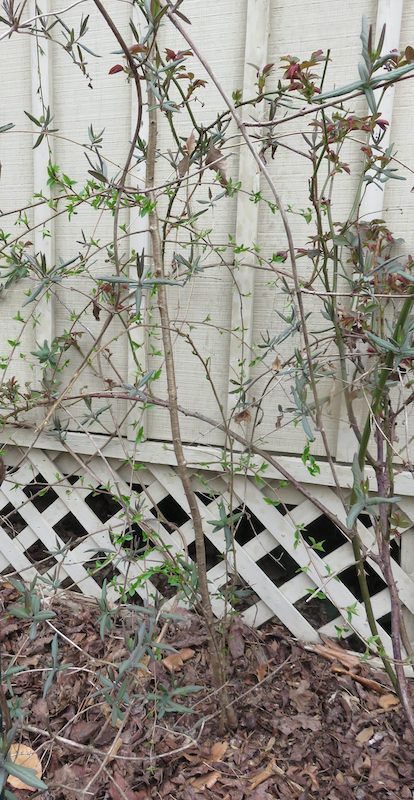
The autumn before I planned to dig this sapling, I used a square shovel to root prune the sapling. Now that spring has arrived, I am re-cutting the roots at about the same distance out as I did in autumn by sinking a flat shovel down as far as it will go.
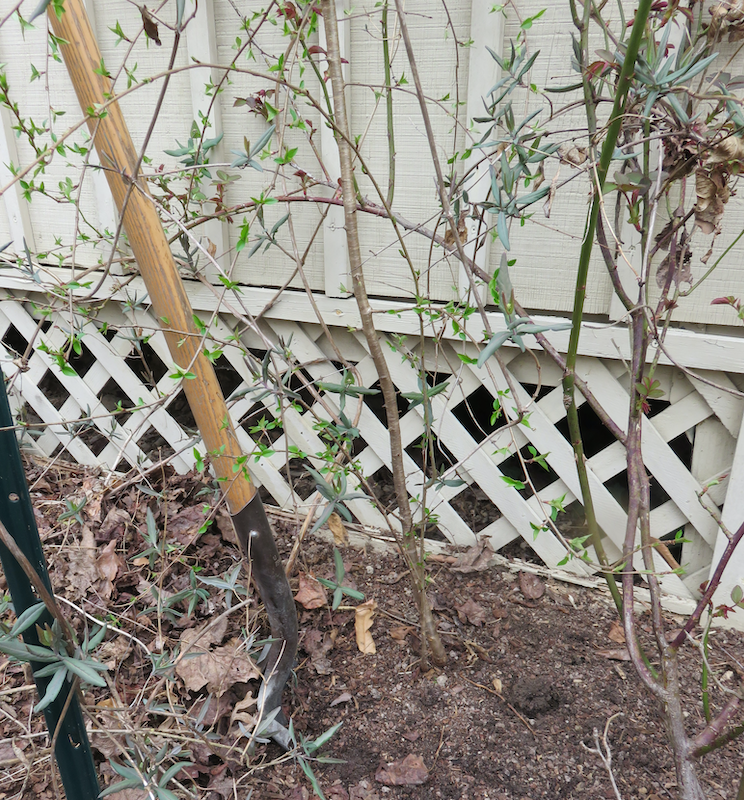
The sapling being lifted from the ground. For a larger tree, this step usually requires cutting several roots, and a couple shovels or pry bars to lever the root ball out of the ground.
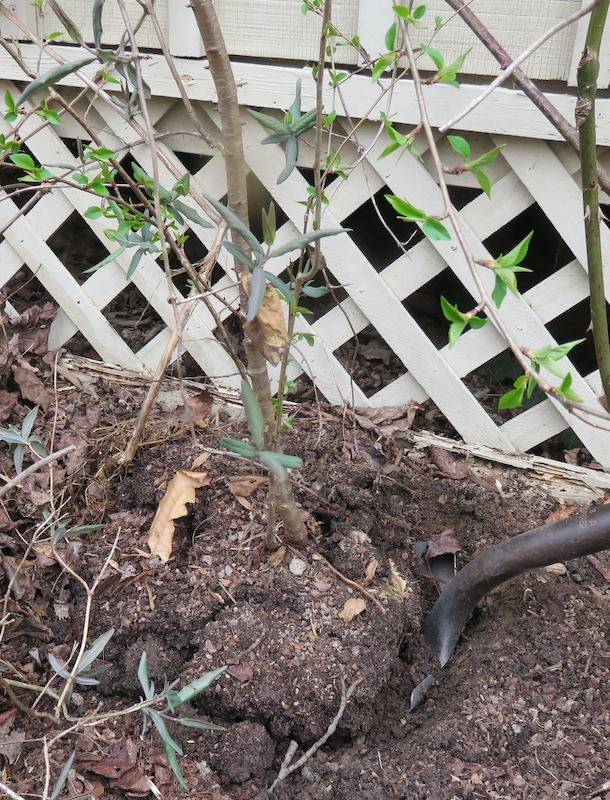
Once the sapling was free of the ground, I knocked the excess soil away from the root ball.
!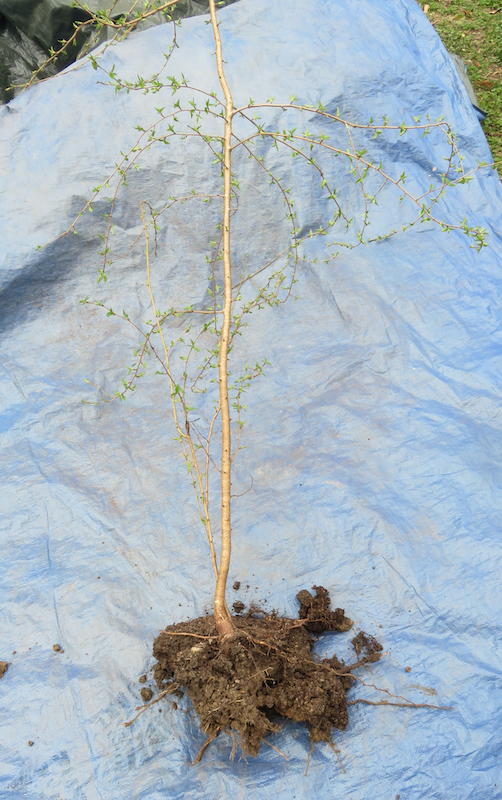

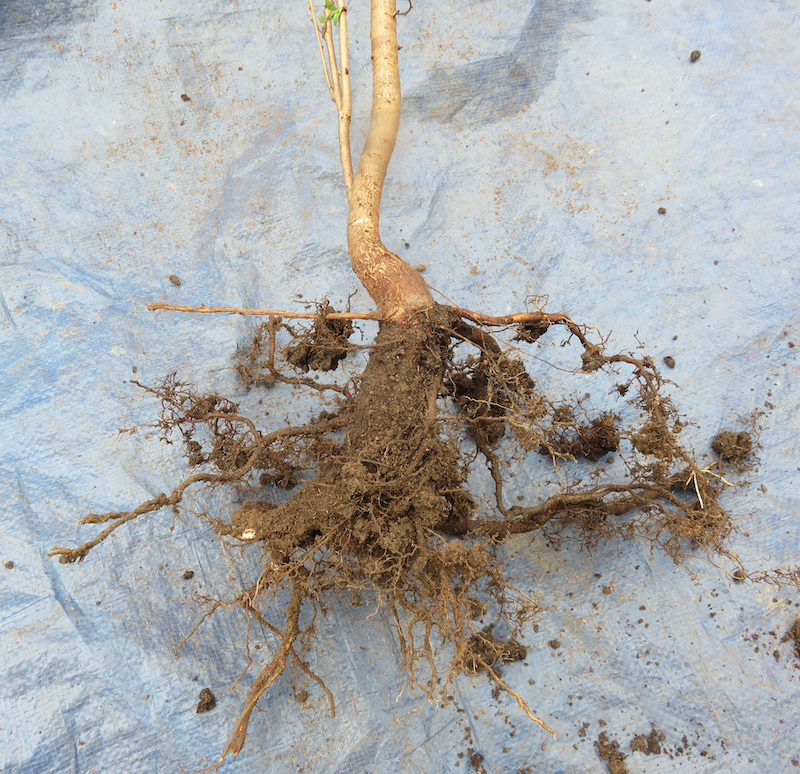
The lifted cherry with most of the field soil removed. Note how few roots there are on the tree. It needs some active intervention to develop more and finer roots. Original image by Dan Johnson.

Once out of the ground, I found that the basal branch actually was a second tree. I decided to plant them in separate fabric root bags to help develop their root masses. See Roots Bags for the rest of the story.
24.3.2 Example 2: Lifting a Larger Tree
24.3.3 Example 3: Sometimes You Just Have to Take a Risk
The preceding discussion may make it sound like every collection has to be meticulously planned. Quite the opposite. Sometimes it is worth taking a risk and breaking one or more rules to collect a unique piece of starting material.
Many years ago, our club took a buying trip to a local production nursery. They had some trees that had been ignored and had long outgrown their containers. I took the next several photos when one of our members took a chance, and decided to dig out a forgotten group of trident maple trees.
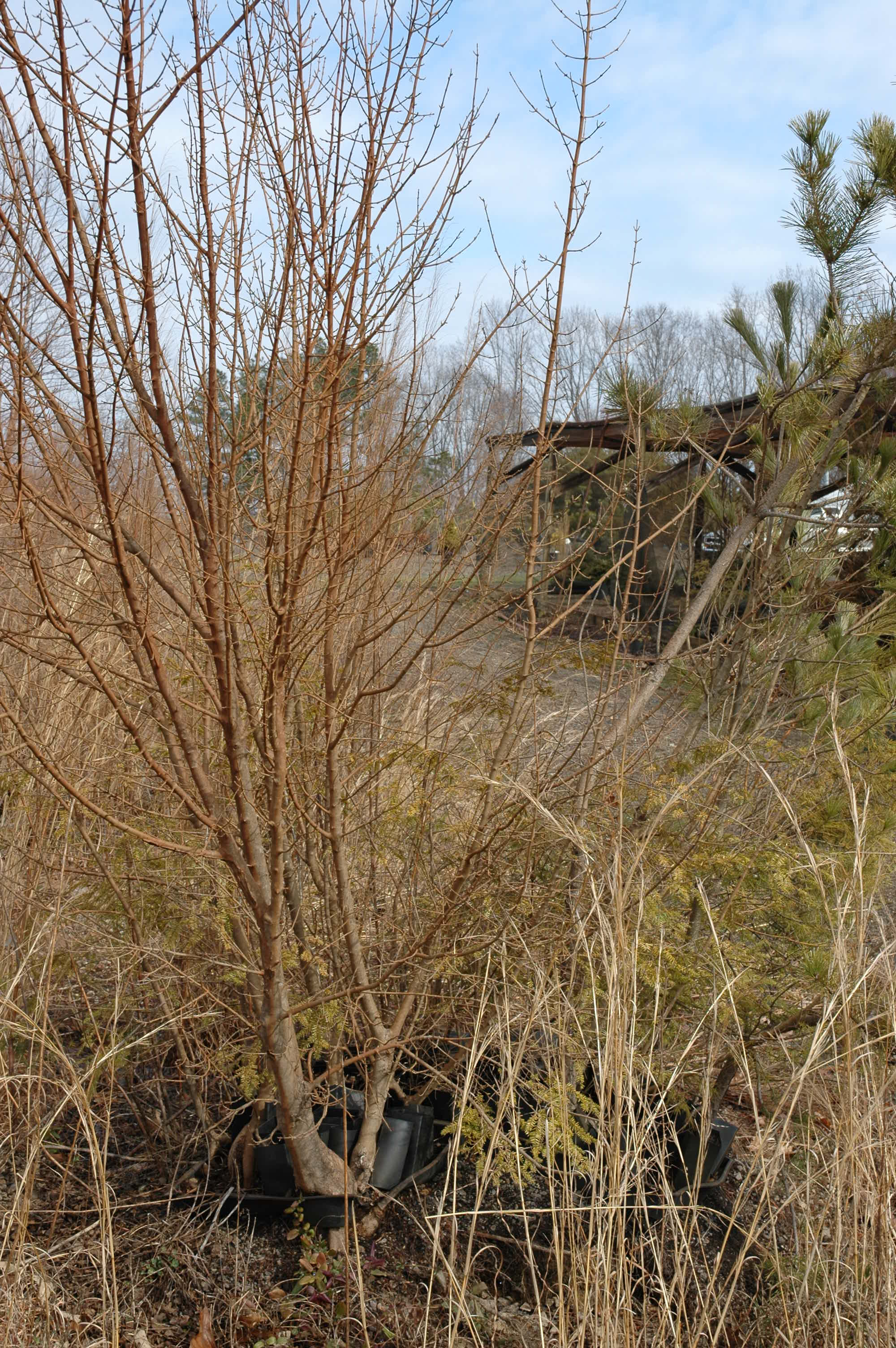
Several trident maples that have outgrown their seedling pots, forming a mass of fused roots. Digging this group out by hand was impractical, because most of the roots had penetrated deep into heavy clay sub-soil that was still stiff from the late winter cold. If that were not enough, the maples were tangled in with the roots of some volunteer pines. Original photo by Dan Johnson.
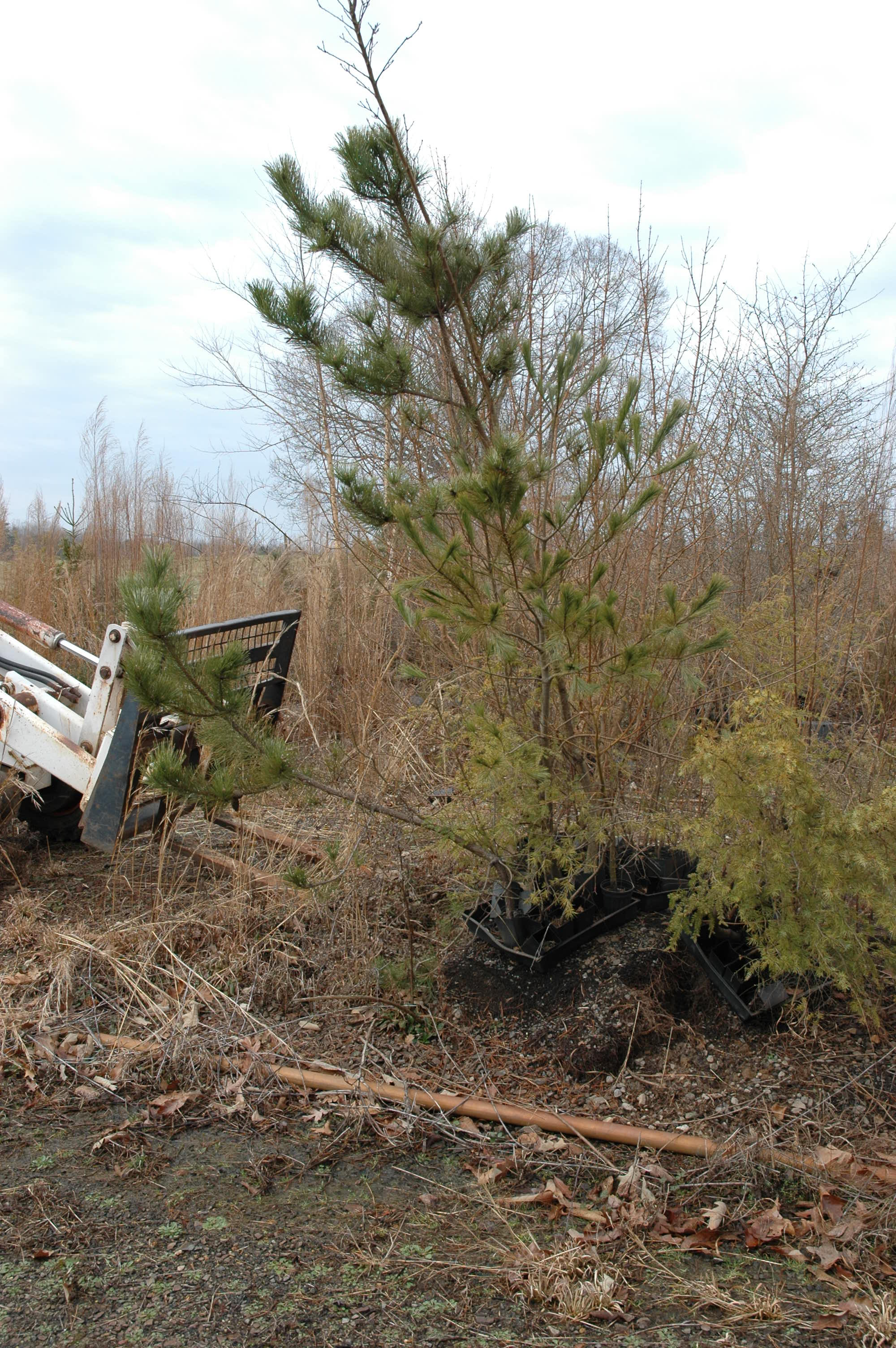
The nursery’s owner kindly offered to use his pallet forks to punch through the clay and pull up the root mass. Original photo by Dan Johnson.

The initial root mass that broke free included the trident maples, two pines, and lots of dead grasses and weed stalks. We guesstimated the weight of that first root mass at over 200 pounds. Original photo by Dan Johnson.
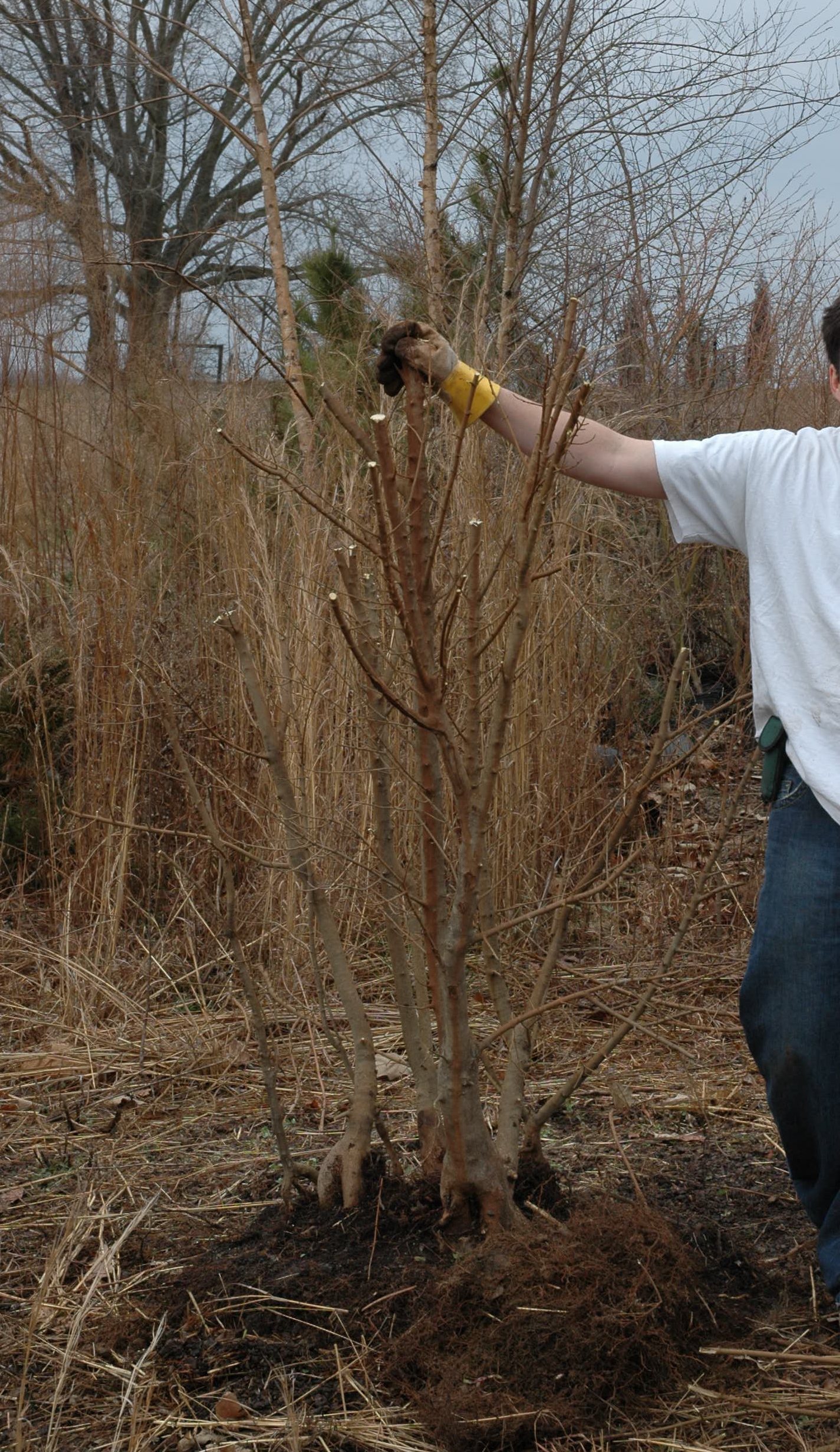

Two views of the pruned, washed trident clump. The pine trees and more than 80% of the raw root ball has been removed. After washing away the remaining soil with a garden hose, the trees still had plenty of fine feeder roots remaining. The clump was potted up in a concrete mixing tub, and survived. New buds broke within a few weeks, which were allowed to grow out for a year before its new owner starting training pruning. Original photo by Dan Johnson.
I do not have a photo of the final tree(s), but the last time I saw them, the clump was healthy, growing strongly, and well on its way to becoming a beautiful specimen. Sometimes, taking a chance is worth the reward.